
Am Fam Physician. 2011;83(2):173-183
A more recent article on nutrition support therapy is available.
Author disclosure: Nothing to disclose.
Specialized nutrition support should be offered to patients who are malnourished or at risk of becoming malnourished when it would benefit patient outcomes or quality of life. Improving the nutritional value of ingested food and tailoring intake to the patient's preferences, abilities, and schedule should be the first measures in addressing nutritional needs. When these interventions alone are insufficient to meet nutritional requirements, oral nutritional supplements should be considered. Nutritional status should be evaluated in patients before specialized nutrition support is considered. Enteral nutrition is used when patients have a functional gastrointestinal tract but are unable to safely swallow. Although a variety of enteral formulas are available, evidence for choosing a specific formula is often lacking. Parenteral nutrition should be used only when enteral nutrition is not feasible. There are no known benefits of parenteral nutrition over the enteral route, and the risk of serious complications is much greater with parenteral nutrition. Even when the parenteral route is necessary, some enteral nutrition is beneficial when possible. Specialized nutrition support can provide an effective bridge until patients are able to return to normal food and, in rare cases, may be continued as long-term home enteral or parenteral nutrition. Specialized nutrition support is not obligatory and can be harmful in cases of futile care and at the end of life.
The decision to administer specialized nutrition support needs to take into consideration three major factors: the patient's preexisting nutritional status, the impact of the disease process on nutritional intake, and the likelihood that specialized nutrition support will improve patient outcome or quality of life.1–11 Figure 1 is an algorithm for the implementation of specialized nutrition support.
| Clinical recommendation | Evidence rating | References |
|---|---|---|
| Nutritional assessment should be based on the patient history and physical data, including weight loss and dietary intake before admission; disease severity; comorbid conditions; and function of the gastrointestinal tract (e.g., Subjective Global Assessment). Serum markers (e.g., albumin, prealbumin, retinol binding protein, transferrin) alone are not adequate. | C | 12, 14–17, 28 |
| The decision to administer specialized nutrition support should consider the patient's preexisting nutritional status, the impact of the disease process on nutritional intake, and the likelihood that specialized nutrition support will improve patient outcome or quality of life. | B | 1–10, 17–26 |
| Enteral nutrition is preferred over parenteral nutrition because it has been shown to be more cost-effective and may decrease the rate of infections. | A | 1, 11, 17, 49 |
| Specialized nutrition support is not obligatory at the end of life. Enteral nutrition is unlikely to be helpful in patients with advanced dementia, and may be harmful. | C | 17, 51–53 |
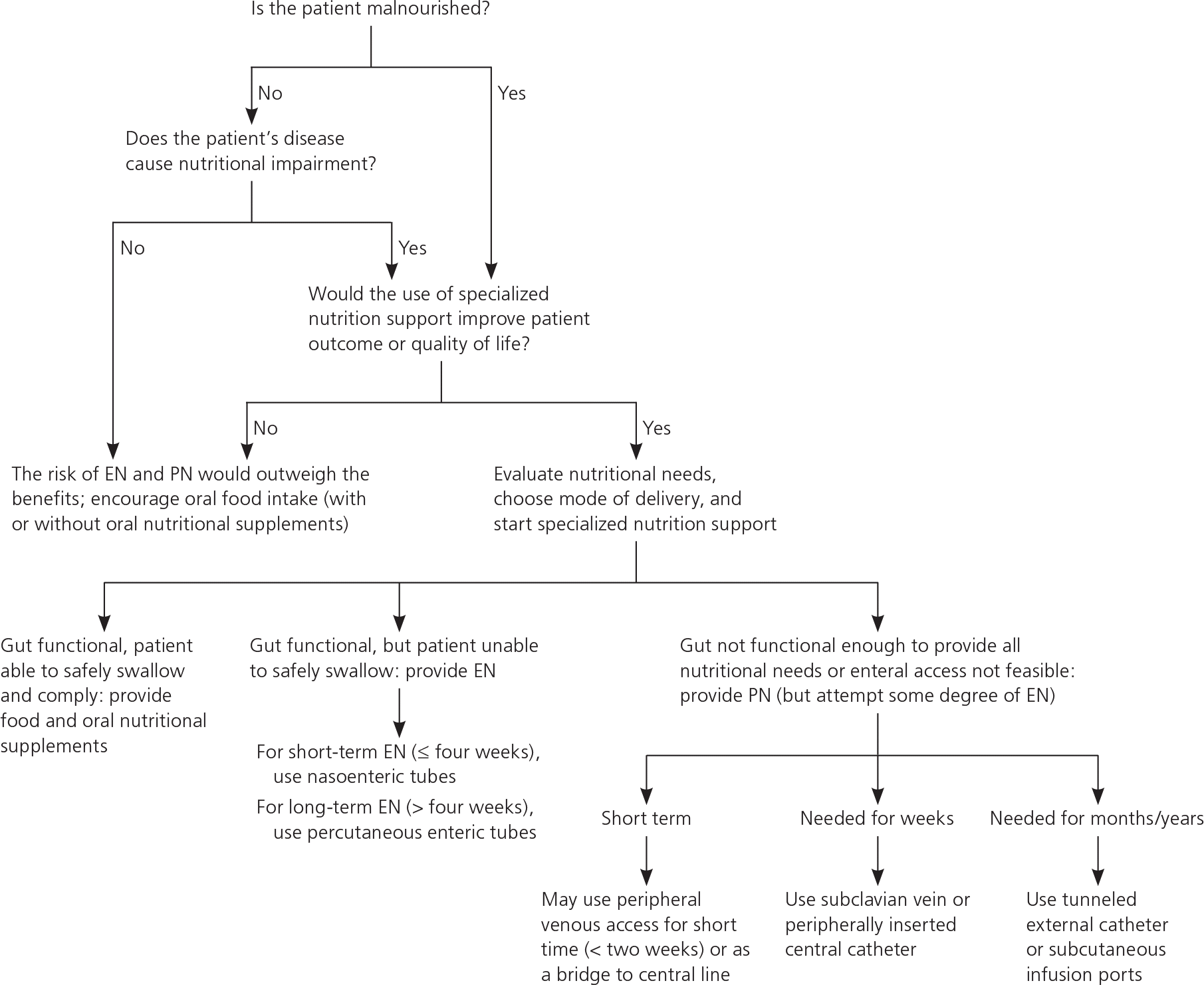
Nutritional status can be evaluated with the Subjective Global Assessment, which uses history and physical data (e.g., weight loss and dietary intake before admission, disease severity, comorbid conditions, function of the gastrointestinal tract) to classify patients as well nourished, moderately malnourished, or severely malnourished12 (Figure 213 ). This screening tool has been validated in children and adults.14 Other indicators such as albumin, prealbumin, retinol binding protein, and transferrin levels reflect nutritional status but are influenced by acute and chronic inflammatory processes.15 An unintentional weight loss of greater than 10 percent over six months may be a sign of protein-calorie malnutrition, and weight loss greater than 20 percent increases the risk of severe protein-calorie malnutrition.
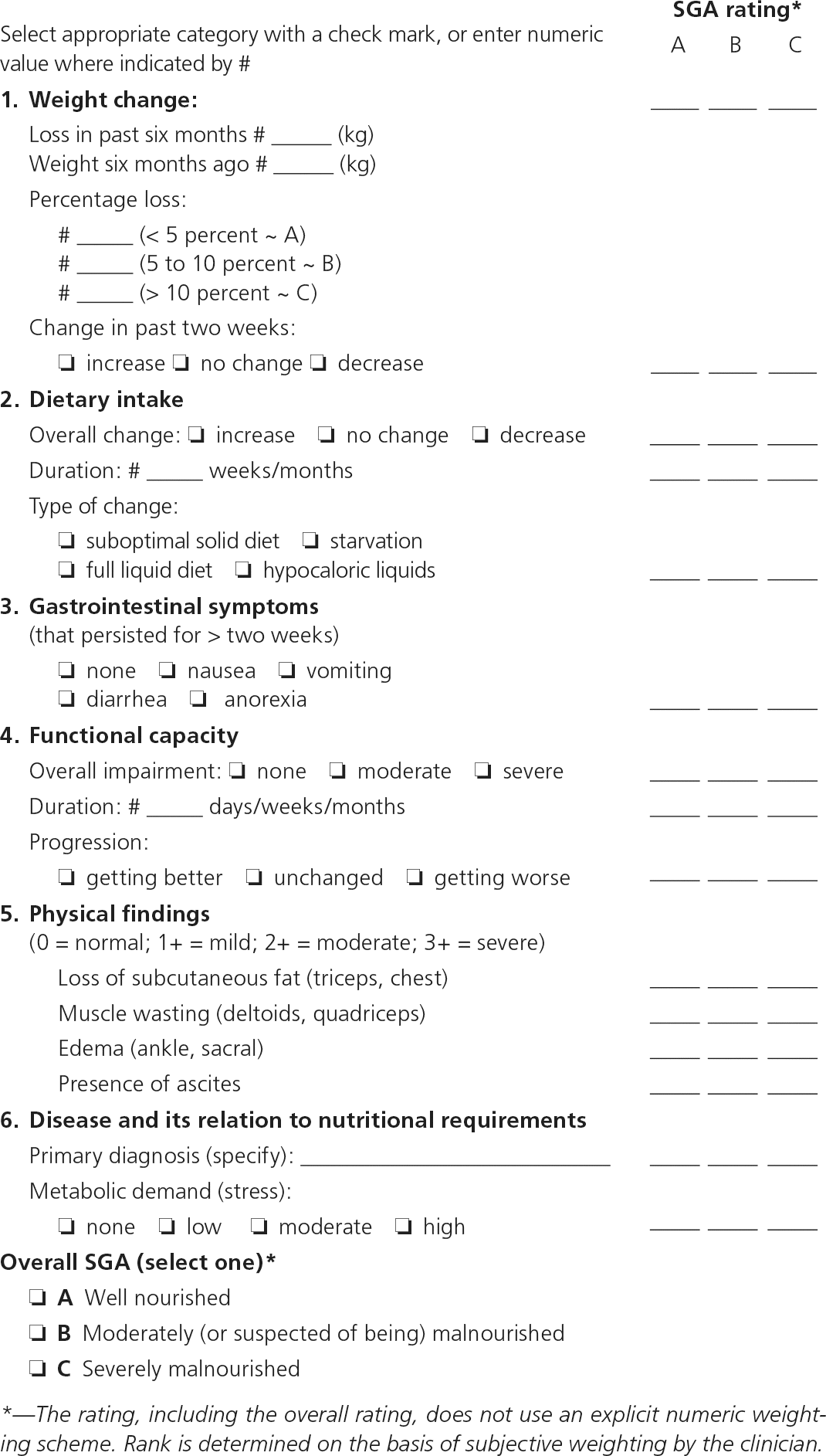
In patients with normal baseline nutritional status, specialized nutrition support should be considered if the underlying disease precludes food intake for more than five to seven days in adults, three to five days in children, or one to three days in infants. Earlier intervention is necessary in patients who are already malnourished or are critically ill.16,17 Estimating the effect of specialized nutrition support on patient outcome is difficult because of the lack of good-quality patient-oriented studies. Thus, the precise indications for nutrition support remain controversial (Table 1).1–7,17–27 According to consensus, specialized nutrition support is indicated for patients with impaired bowel function (e.g., short bowl syndrome, necrotizing enterocolitis), severe prolonged hypercatabolic states, or severe protein-calorie malnutrition and a treatable disease, and for those requiring prolonged therapeutic bowel rest (e.g., inflammatory bowel disease).
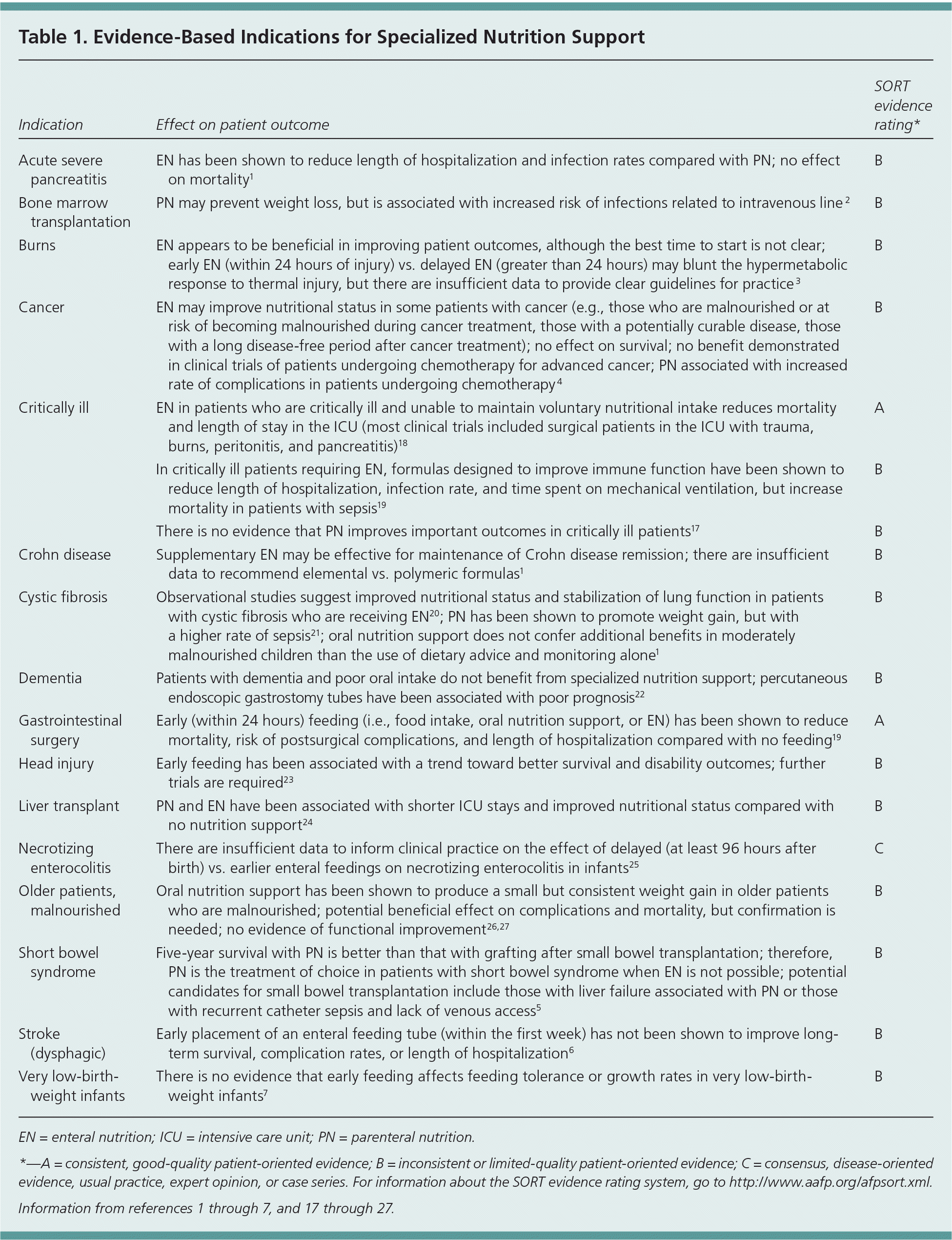
| Indication | Effect on patient outcome | SORT evidence rating* |
|---|---|---|
| Acute severe pancreatitis | EN has been shown to reduce length of hospitalization and infection rates compared with PN; no effect on mortality1 | B |
| Bone marrow transplantation | PN may prevent weight loss, but is associated with increased risk of infections related to intravenous line2 | B |
| Burns | EN appears to be beneficial in improving patient outcomes, although the best time to start is not clear; early EN (within 24 hours of injury) vs. delayed EN (greater than 24 hours) may blunt the hypermetabolic response to thermal injury, but there are insufficient data to provide clear guidelines for practice3 | B |
| Cancer | EN may improve nutritional status in some patients with cancer (e.g., those who are malnourished or at risk of becoming malnourished during cancer treatment, those with a potentially curable disease, those with a long disease-free period after cancer treatment); no effect on survival; no benefit demonstrated in clinical trials of patients undergoing chemotherapy for advanced cancer; PN associated with increased rate of complications in patients undergoing chemotherapy4 | B |
| Critically ill | EN in patients who are critically ill and unable to maintain voluntary nutritional intake reduces mortality and length of stay in the ICU (most clinical trials included surgical patients in the ICU with trauma, burns, peritonitis, and pancreatitis)18 | A |
| In critically ill patients requiring EN, formulas designed to improve immune function have been shown to reduce length of hospitalization, infection rate, and time spent on mechanical ventilation, but increase mortality in patients with sepsis19 | B | |
| There is no evidence that PN improves important outcomes in critically ill patients17 | B | |
| Crohn disease | Supplementary EN may be effective for maintenance of Crohn disease remission; there are insufficient data to recommend elemental vs. polymeric formulas1 | B |
| Cystic fibrosis | Observational studies suggest improved nutritional status and stabilization of lung function in patients with cystic fibrosis who are receiving EN20; PN has been shown to promote weight gain, but with a higher rate of sepsis21; oral nutrition support does not confer additional benefits in moderately malnourished children than the use of dietary advice and monitoring alone1 | B |
| Dementia | Patients with dementia and poor oral intake do not benefit from specialized nutrition support; percutaneous endoscopic gastrostomy tubes have been associated with poor prognosis22 | B |
| Gastrointestinal surgery | Early (within 24 hours) feeding (i.e., food intake, oral nutrition support, or EN) has been shown to reduce mortality, risk of postsurgical complications, and length of hospitalization compared with no feeding19 | A |
| Head injury | Early feeding has been associated with a trend toward better survival and disability outcomes; further trials are required23 | B |
| Liver transplant | PN and EN have been associated with shorter ICU stays and improved nutritional status compared with no nutrition support24 | B |
| Necrotizing enterocolitis | There are insufficient data to inform clinical practice on the effect of delayed (at least 96 hours after birth) vs. earlier enteral feedings on necrotizing enterocolitis in infants25 | C |
| Older patients, malnourished | Oral nutrition support has been shown to produce a small but consistent weight gain in older patients who are malnourished; potential beneficial effect on complications and mortality, but confirmation is needed; no evidence of functional improvement26,27 | B |
| Short bowel syndrome | Five-year survival with PN is better than that with grafting after small bowel transplantation; therefore, PN is the treatment of choice in patients with short bowel syndrome when EN is not possible; potential candidates for small bowel transplantation include those with liver failure associated with PN or those with recurrent catheter sepsis and lack of venous access5 | B |
| Stroke (dysphagic) | Early placement of an enteral feeding tube (within the first week) has not been shown to improve long-term survival, complication rates, or length of hospitalization6 | B |
| Very low-birth-weight infants | There is no evidence that early feeding affects feeding tolerance or growth rates in very low-birth-weight infants7 | B |
Estimating Nutritional Requirements
In adults, the average nutritional requirement is 25 to 35 kcal per kg per day. For children older than five years, the suggested requirement is 1,500 kcal for the first 20 kg plus 25 kcal for each additional kg per day.28 Protein requirements range from 0.8 to 1.5 g per kg per day in adults, but may be higher in patients who are hypercatabolic or losing protein (e.g., those with enteropathy or acute nephritic syndrome).8 Protein requirements are higher in infants and children.9 Children and adults receiving specialized nutrition support should get 2 to 4 percent of their total calories as linoleic acid to prevent essential fatty acid deficiency. When the need for specialized nutrition support is expected to be prolonged, consultation with an appropriate nutrition support professional is recommended.
Oral Nutritional Supplements
Oral nutritional supplements can be used to meet nutritional requirements when the patient has a functional gastrointestinal tract and swallowing mechanism, and accepts the nutritional plan of care. When possible, efforts should be made to improve dietary intake using regular food. If this approach fails, oral nutritional supplements may be considered. Studies assessing the effect of oral nutritional supplements in patients with various chronic diseases have found minimal or no benefit over dietary counseling alone.26,27 Oral supplements are often used inappropriately, leading to waste and increased costs.29
Enteral Nutrition
INDICATIONS
Enteral nutrition may be considered to meet the nutritional needs of patients with a functional gastrointestinal tract but who are unable to safely swallow.11,17 Even when the gut cannot absorb 100 percent of nutritional needs, some enteral nutrition should be attempted. Enteral nutrition has been shown to be more cost-effective than parenteral nutrition. In addition, studies show that enteral nutrition may decrease the rate of infections30 and maintain gastrointestinal tract hormones and bile flow, thus reducing the hepatic and metabolic complications that are associated with the parenteral route.
DELIVERY
Enteral nutrition can be administered through a nasogastric, nasoduodenal, or enterostomy tube (gastrostomy or jejunostomy). Enterostomy tubes are indicated when the duration of enteral nutrition is anticipated to be longer than four weeks.10 Gastric feeding is more physiologic, is easier to administer (i.e., bolus feeding with no need for delivery devices for continuous administration), and allows for a larger volume and higher osmotic load than the small intestine). Postpyloric feeding may be beneficial in patients at high risk of aspiration, severe esophagitis, gastric dysmotility or obstruction, recurrent emesis, and pancreatitis. Table 2 outlines the most common complications of enteral nutrition.31–34
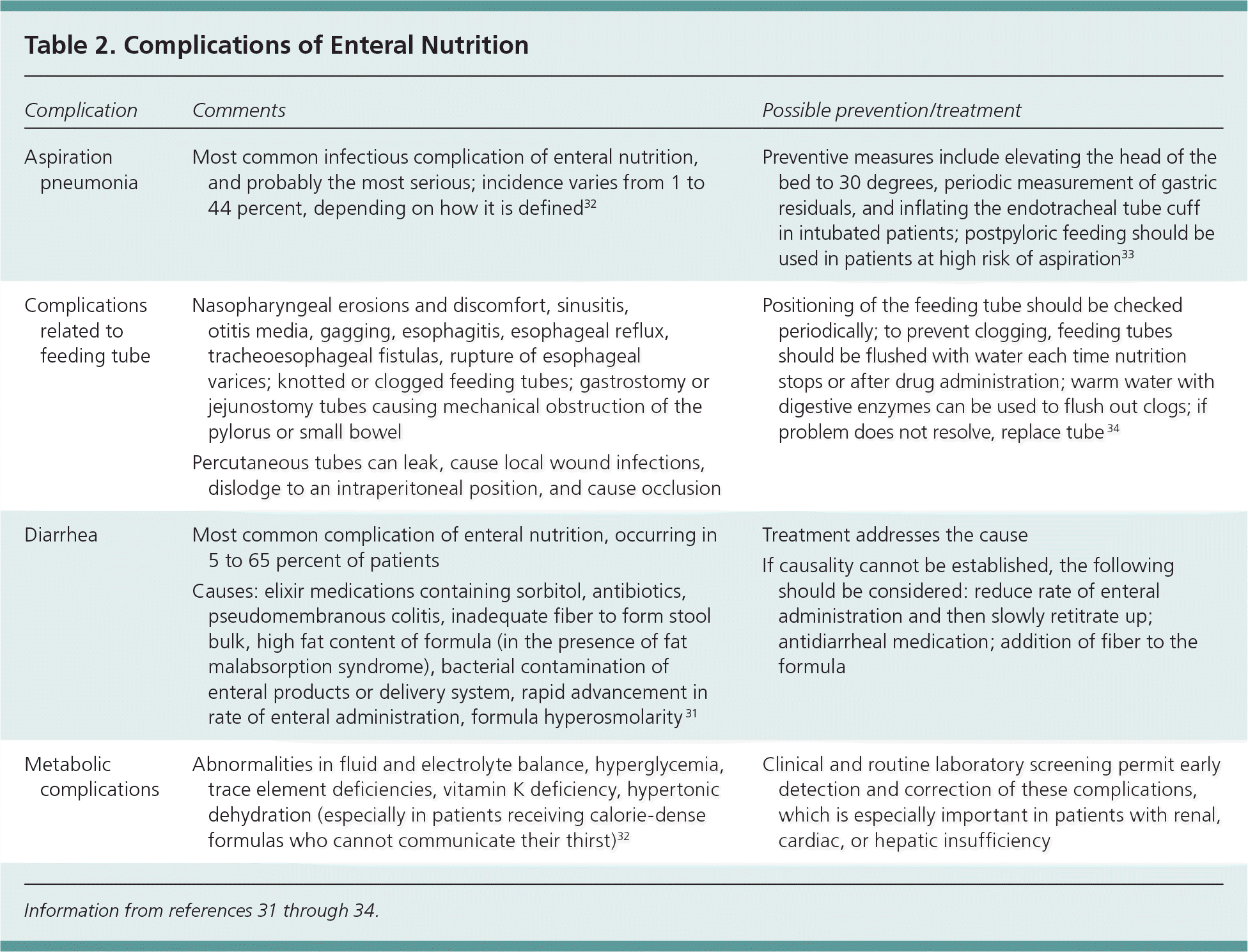
| Complication | Comments | Possible prevention/treatment |
|---|---|---|
| Aspiration pneumonia | Most common infectious complication of enteral nutrition, and probably the most serious; incidence varies from 1 to 44 percent, depending on how it is defined32 | Preventive measures include elevating the head of the bed to 30 degrees, periodic measurement of gastric residuals, and inflating the endotracheal tube cuff in intubated patients; postpyloric feeding should be used in patients at high risk of aspiration33 |
| Complications related to feeding tube | Nasopharyngeal erosions and discomfort, sinusitis, otitis media, gagging, esophagitis, esophageal reflux, tracheoesophageal fistulas, rupture of esophageal varices; knotted or clogged feeding tubes; gastrostomy or jejunostomy tubes causing mechanical obstruction of the pylorus or small bowel | Positioning of the feeding tube should be checked periodically; to prevent clogging, feeding tubes should be flushed with water each time nutrition stops or after drug administration; warm water with digestive enzymes can be used to flush out clogs; if problem does not resolve, replace tube34 |
| Percutaneous tubes can leak, cause local wound infections, dislodge to an intraperitoneal position, and cause occlusion | ||
| Diarrhea | Most common complication of enteral nutrition, occurring in 5 to 65 percent of patients | Treatment addresses the cause If causality cannot be established, the following should be considered: reduce rate of enteral administration and then slowly retitrate up; antidiarrheal medication; addition of fiber to the formula |
| Causes: elixir medications containing sorbitol, antibiotics, pseudomembranous colitis, inadequate fiber to form stool bulk, high fat content of formula (in the presence of fat malabsorption syndrome), bacterial contamination of enteral products or delivery system, rapid advancement in rate of enteral administration, formula hyperosmolarity31 | ||
| Metabolic complications | Abnormalities in fluid and electrolyte balance, hyperglycemia, trace element deficiencies, vitamin K deficiency, hypertonic dehydration (especially in patients receiving calorie-dense formulas who cannot communicate their thirst)32 | Clinical and routine laboratory screening permit early detection and correction of these complications, which is especially important in patients with renal, cardiac, or hepatic insufficiency |
ENTERAL FORMULAS
Enteral nutrition can be divided into two basic categories: polymeric or elemental. These categories can be further divided into standard, disease-specific, and immunomodulating formulas. Formulas for infants (younger than one year) and children (one to 10 years of age) have been developed. The clinical evidence for choosing a specific enteral formula is often lacking. Table 3 summarizes enteral and oral nutritional formulas.35–38
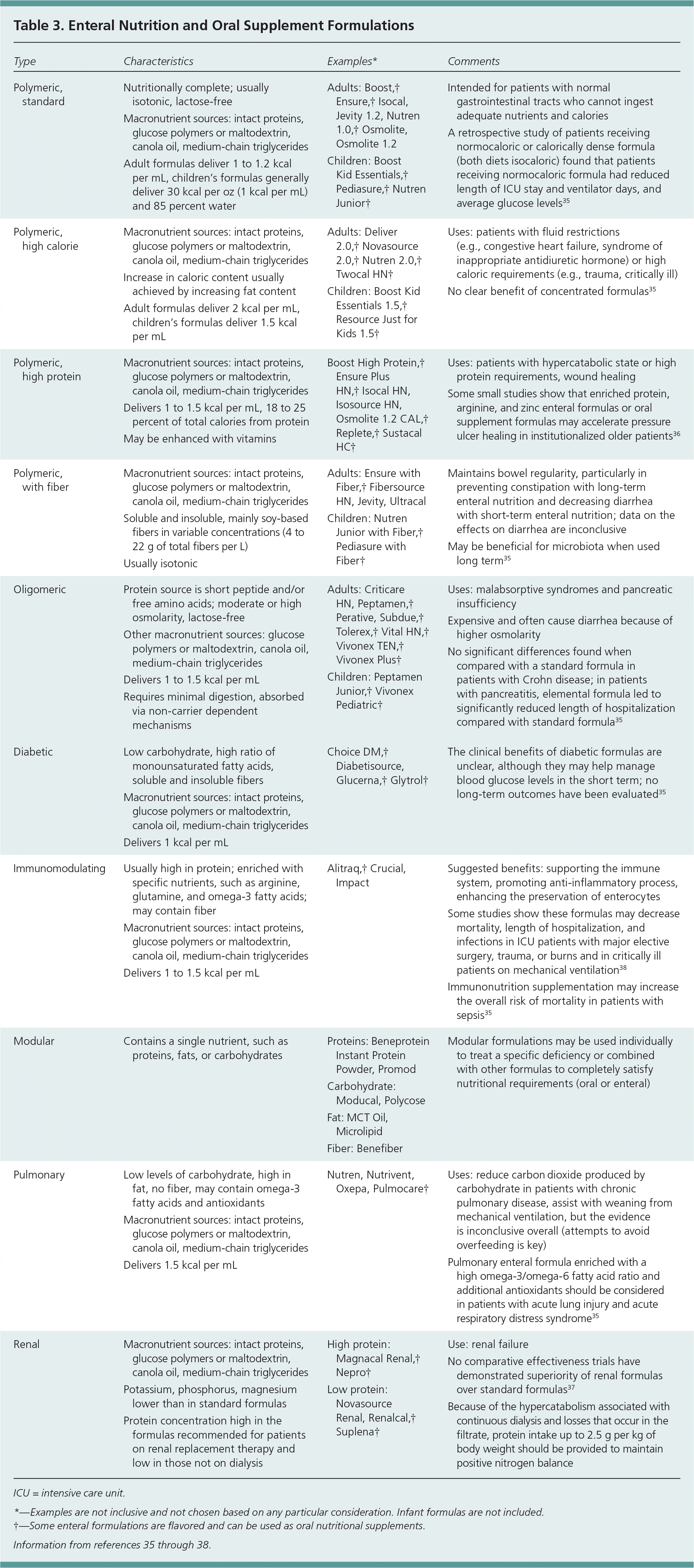
| Type | Characteristics | Examples* | Comments |
|---|---|---|---|
| Polymeric, standard | Nutritionally complete; usually isotonic, lactose-free |
| |
| Macronutrient sources: intact proteins, glucose polymers or maltodextrin, canola oil, medium-chain triglycerides | |||
| Adult formulas deliver 1 to 1.2 kcal per mL, children's formulas generally deliver 30 kcal per oz (1 kcal per mL) and 85 percent water | |||
| Polymeric, high calorie | Macronutrient sources: intact proteins, glucose polymers or maltodextrin, canola oil, medium-chain triglycerides |
| |
| Increase in caloric content usually achieved by increasing fat content | |||
| Adult formulas deliver 2 kcal per mL, children's formulas deliver 1.5 kcal per mL | |||
| Polymeric, high protein | Macronutrient sources: intact proteins, glucose polymers or maltodextrin, canola oil, medium-chain triglycerides |
| |
| Delivers 1 to 1.5 kcal per mL, 18 to 25 percent of total calories from protein | |||
| May be enhanced with vitamins | |||
| Polymeric, with fiber | Macronutrient sources: intact proteins, glucose polymers or maltodextrin, canola oil, medium-chain triglycerides |
| |
| Soluble and insoluble, mainly soy-based fibers in variable concentrations (4 to 22 g of total fibers per L) | |||
| Usually isotonic | |||
| Oligomeric | Protein source is short peptide and/or free amino acids; moderate or high osmolarity, lactose-free |
| |
| Other macronutrient sources: glucose polymers or maltodextrin, canola oil, medium-chain triglycerides | |||
| Delivers 1 to 1.5 kcal per mL | |||
| Requires minimal digestion, absorbed via non-carrier dependent mechanisms | |||
| Diabetic | Low carbohydrate, high ratio of monounsaturated fatty acids, soluble and insoluble fibers |
| |
| Macronutrient sources: intact proteins, glucose polymers or maltodextrin, canola oil, medium-chain triglycerides | |||
| Delivers 1 kcal per mL | |||
| Immunomodulating | Usually high in protein; enriched with specific nutrients, such as arginine, glutamine, and omega-3 fatty acids; may contain fiber |
|
|
| Macronutrient sources: intact proteins, glucose polymers or maltodextrin, canola oil, medium-chain triglycerides | |||
| Delivers 1 to 1.5 kcal per mL | |||
| Modular | Contains a single nutrient, such as proteins, fats, or carbohydrates |
|
|
| Pulmonary | Low levels of carbohydrate, high in fat, no fiber, may contain omega-3 fatty acids and antioxidants |
|
|
| Macronutrient sources: intact proteins, glucose polymers or maltodextrin, canola oil, medium-chain triglycerides | |||
| Delivers 1.5 kcal per mL | |||
| Renal | Macronutrient sources: intact proteins, glucose polymers or maltodextrin, canola oil, medium-chain triglycerides |
| |
| Potassium, phosphorus, magnesium lower than in standard formulas | |||
| Protein concentration high in the formulas recommended for patients on renal replacement therapy and low in those not on dialysis |
Parenteral Nutrition
INDICATIONS
Parenteral nutrition refers to the administration of nutrients via a dedicated central or peripheral line. It is used in patients with gastrointestinal tract dysfunction (e.g., ileus or other obstruction, severe dysmotility, fistulae, surgical resection, severe malabsorption) that precludes adequate nutrient absorption.
CONTRAINDICATIONS
Parenteral nutrition should not be used when the gastrointestinal tract is functional, except when enteral nutrition is impossible or impractical because of tube access. Hyperglycemia (serum glucose level of 300 mg per dL [16.65 mmol per L] or greater), electrolyte abnormalities, or severe fluid overload need to be corrected before initiation of parenteral nutrition.17
VENOUS ACCESS
Peripheral venous access can be used in patients who require parenteral nutrition for less than two weeks. However, providing nutrition through peripheral venous access is limited because formulas with osmolarity greater than 850 mOsm per L (850 mmol per L) are poorly tolerated peripherally. Total parenteral nutrition using such formulas would require a large volume of fluids, and would result in fluid overload in most patients. Therefore, central venous access is usually needed to allow for administration of higher osmolarity formulas. Central venous access includes peripherally inserted central catheters or centrally placed catheters for short-term placement, and tunneled catheters or implanted ports for long-term placement.
TOTAL PARENTERAL NUTRITION FORMULATIONS
Total parenteral nutrition is formulated to meet the patient's individual nutritional requirements and is most commonly provided as a two-in-one mixture of dextrose and amino acids, with fat emulsions infused as a separate solution. Typical formulas for central venous access contain 25 to 35 percent dextrose and 2.75 to 6 percent amino acids, depending on the patient's estimated nutrient and water requirements.11 These formulas have osmolarities in excess of 1,800 mOsm per L (1,800 mmol per L). Formulas for peripheral infusion contain 5 to 10 percent dextrose and 2.75 to 4.25 percent amino acids, and have osmolarities of 600 to 900 mOsm per L (600 to 900 mmol per L). L-cysteine is added to the amino acid formulations for neonates and infants to improve nitrogen balance.39
Parenteral fat emulsions are available in concentrations of 10, 20, and 30 percent and are relatively isosmotic. Intravenous fat has been shown to be equivalent to intravenous dextrose in providing energy to prevent protein breakdown. Intravenous fat is associated with less glucose intolerance, less carbon dioxide production, and less fatty infiltration of the liver, and has been increasingly used in patients with hyperglycemia, respiratory failure, and liver disease. However, there is limited clinical benefit when fat content exceeds 30 to 40 percent of nonprotein calories.
Minerals, vitamins, and other additives are incorporated into total parenteral nutrition formulations to meet daily nutritional needs (Table 48,10,11,17 ). The requirements for minerals and vitamins in parenteral nutrition are significantly different than the recommended daily allowance because issues with enteral absorption and bioavailability are overcome by direct intravenous administration. Addition of medications to parenteral nutrition formulas is generally not advised because of possible drug-nutrient interactions.
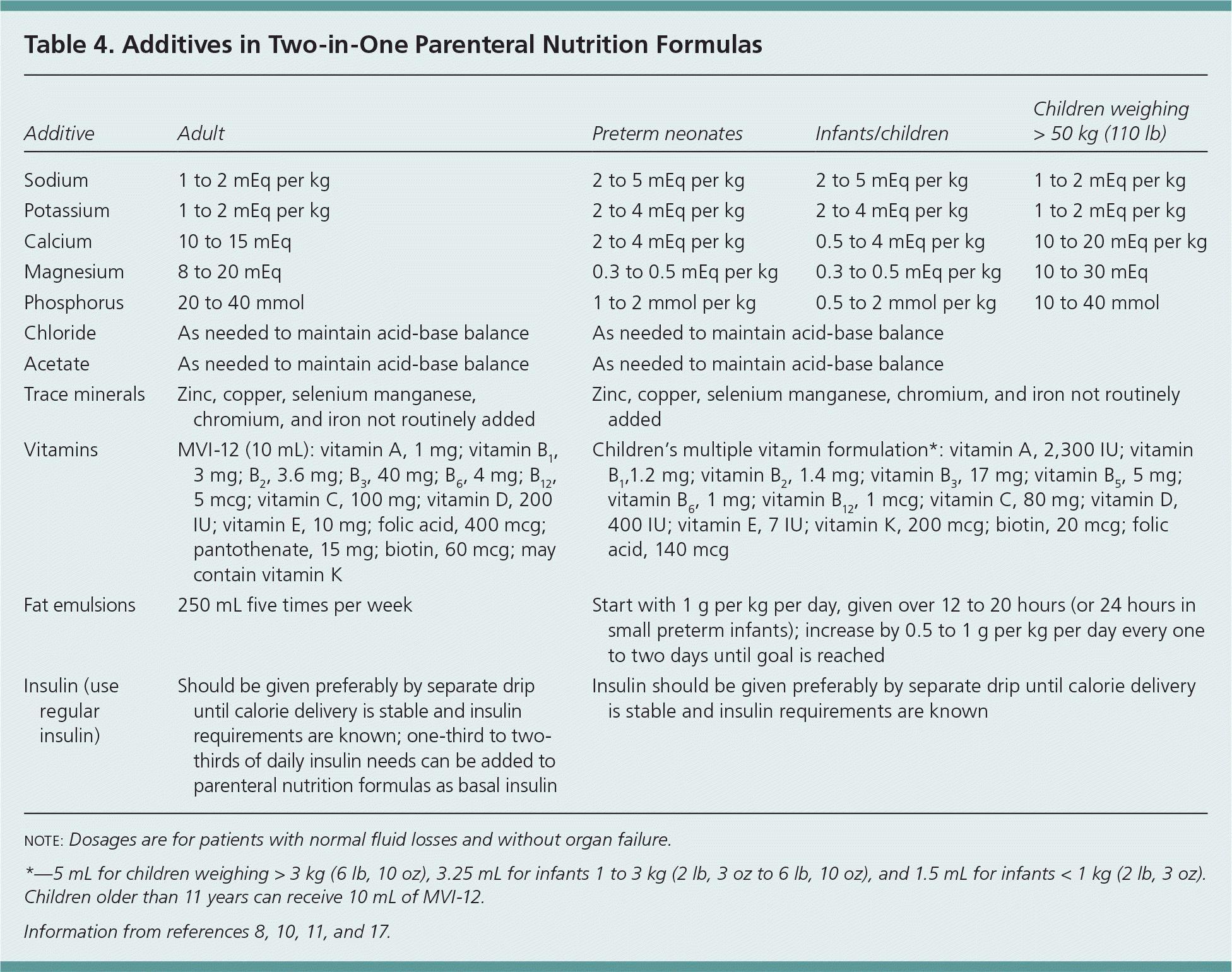
| Additive | Adult | Preterm neonates | Infants/children | Children weighing > 50 kg (110 lb) |
|---|---|---|---|---|
| Sodium | 1 to 2 mEq per kg | 2 to 5 mEq per kg | 2 to 5 mEq per kg | 1 to 2 mEq per kg |
| Potassium | 1 to 2 mEq per kg | 2 to 4 mEq per kg | 2 to 4 mEq per kg | 1 to 2 mEq per kg |
| Calcium | 10 to 15 mEq | 2 to 4 mEq per kg | 0.5 to 4 mEq per kg | 10 to 20 mEq per kg |
| Magnesium | 8 to 20 mEq | 0.3 to 0.5 mEq per kg | 0.3 to 0.5 mEq per kg | 10 to 30 mEq |
| Phosphorus | 20 to 40 mmol | 1 to 2 mmol per kg | 0.5 to 2 mmol per kg | 10 to 40 mmol |
| Chloride | As needed to maintain acid-base balance | As needed to maintain acid-base balance | ||
| Acetate | As needed to maintain acid-base balance | As needed to maintain acid-base balance | ||
| Trace minerals | Zinc, copper, selenium manganese, chromium, and iron not routinely added | Zinc, copper, selenium manganese, chromium, and iron not routinely added | ||
| Vitamins | MVI-12 (10 mL): vitamin A, 1 mg; vitamin B1, 3 mg; B2, 3.6 mg; B3, 40 mg; B6, 4 mg; B12, 5 mcg; vitamin C, 100 mg; vitamin D, 200 IU; vitamin E, 10 mg; folic acid, 400 mcg; pantothenate, 15 mg; biotin, 60 mcg; may contain vitamin K | Children's multiple vitamin formulation*: vitamin A, 2,300 IU; vitamin B1,1.2 mg; vitamin B2, 1.4 mg; vitamin B3, 17 mg; vitamin B5, 5 mg; vitamin B6, 1 mg; vitamin B12, 1 mcg; vitamin C, 80 mg; vitamin D, 400 IU; vitamin E, 7 IU; vitamin K, 200 mcg; biotin, 20 mcg; folic acid, 140 mcg | ||
| Fat emulsions | 250 mL five times per week | Start with 1 g per kg per day, given over 12 to 20 hours (or 24 hours in small preterm infants); increase by 0.5 to 1 g per kg per day every one to two days until goal is reached | ||
| Insulin (use regular insulin) | Should be given preferably by separate drip until calorie delivery is stable and insulin requirements are known; one-third to two-thirds of daily insulin needs can be added to parenteral nutrition formulas as basal insulin | Insulin should be given preferably by separate drip until calorie delivery is stable and insulin requirements are known | ||
COMPLICATIONS
Parenteral nutrition poses numerous potentially serious complications (Table 5).11,40–48 Infectious complications are most common and are often related to suboptimal catheter care and inadequate patient education. Metabolic complications can be diminished by appropriate monitoring and adjustments in the composition and rate of parenteral nutrition infusion. Nevertheless, bone resorption and especially liver disease associated with parenteral nutrition are challenging to manage. In some cases of severe liver disease, intestinal or liver transplantation may be the only treatment option.49
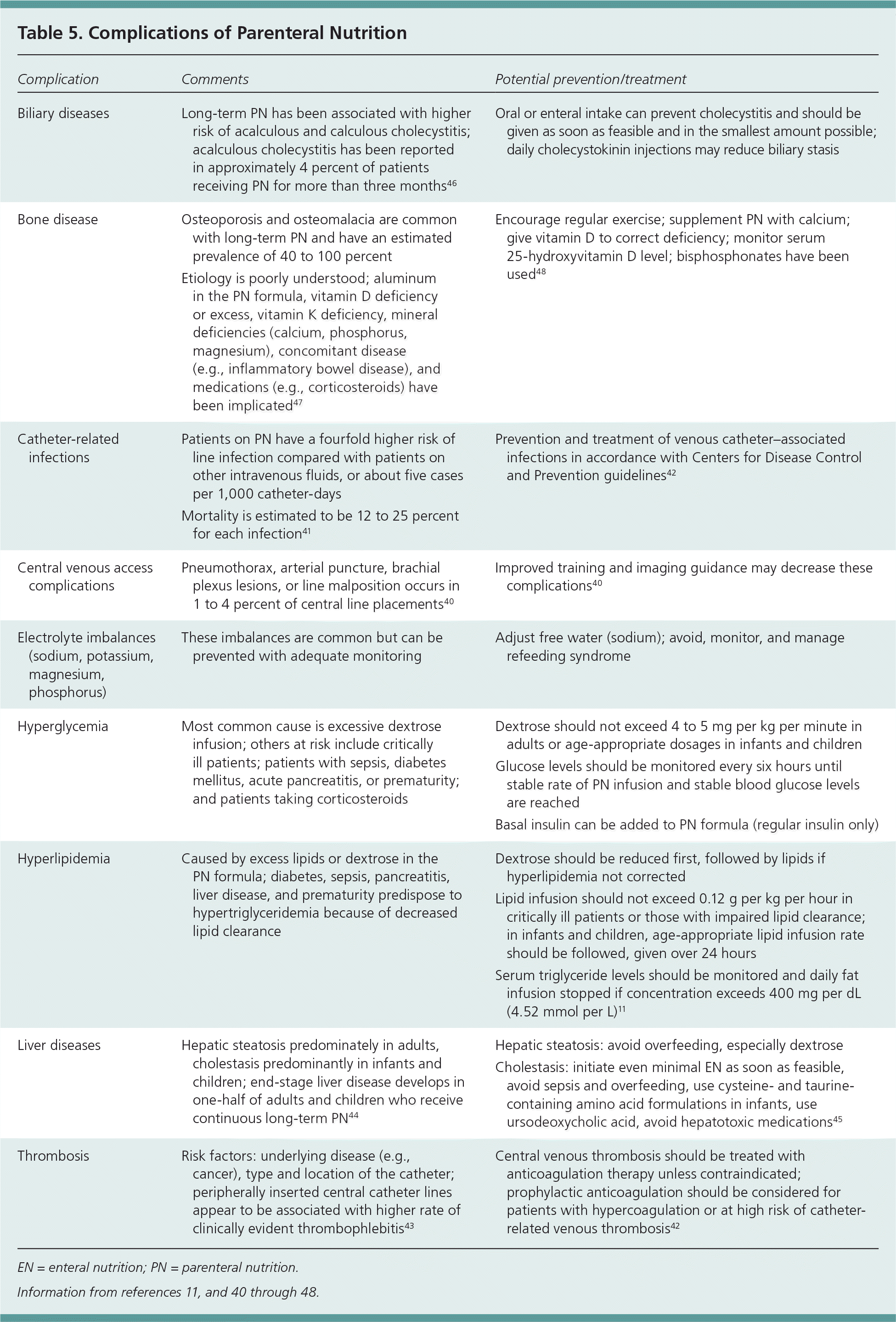
| Complication | Comments | Potential prevention/treatment |
|---|---|---|
| Biliary diseases | Long-term PN has been associated with higher risk of acalculous and calculous cholecystitis; acalculous cholecystitis has been reported in approximately 4 percent of patients receiving PN for more than three months46 | Oral or enteral intake can prevent cholecystitis and should be given as soon as feasible and in the smallest amount possible; daily cholecystokinin injections may reduce biliary stasis |
| Bone disease | Osteoporosis and osteomalacia are common with long-term PN and have an estimated prevalence of 40 to 100 percent | Encourage regular exercise; supplement PN with calcium; give vitamin D to correct deficiency; monitor serum 25-hydroxyvitamin D level; bisphosphonates have been used48 |
| Etiology is poorly understood; aluminum in the PN formula, vitamin D deficiency or excess, vitamin K deficiency, mineral deficiencies (calcium, phosphorus, magnesium), concomitant disease (e.g., inflammatory bowel disease), and medications (e.g., corticosteroids) have been implicated47 | ||
| Catheter-related infections | Patients on PN have a fourfold higher risk of line infection compared with patients on other intravenous fluids, or about five cases per 1,000 catheter-days | Prevention and treatment of venous catheter– associated infections in accordance with Centers for Disease Control and Prevention guidelines42 |
| Mortality is estimated to be 12 to 25 percent for each infection41 | ||
| Central venous access complications | Pneumothorax, arterial puncture, brachial plexus lesions, or line malposition occurs in 1 to 4 percent of central line placements40 | Improved training and imaging guidance may decrease these complications40 |
| Electrolyte imbalances (sodium, potassium, magnesium, phosphorus) | These imbalances are common but can be prevented with adequate monitoring | Adjust free water (sodium); avoid, monitor, and manage refeeding syndrome |
| Hyperglycemia | Most common cause is excessive dextrose infusion; others at risk include critically ill patients; patients with sepsis, diabetes mellitus, acute pancreatitis, or prematurity; and patients taking corticosteroids | Dextrose should not exceed 4 to 5 mg per kg per minute in adults or age-appropriate dosages in infants and children |
| Glucose levels should be monitored every six hours until stable rate of PN infusion and stable blood glucose levels are reached | ||
| Basal insulin can be added to PN formula (regular insulin only) | ||
| Hyperlipidemia | Caused by excess lipids or dextrose in the PN formula; diabetes, sepsis, pancreatitis, liver disease, and prematurity predispose to hypertriglyceridemia because of decreased lipid clearance | Dextrose should be reduced first, followed by lipids if hyperlipidemia not corrected |
| Lipid infusion should not exceed 0.12 g per kg per hour in critically ill patients or those with impaired lipid clearance; in infants and children, age-appropriate lipid infusion rate should be followed, given over 24 hours | ||
| Serum triglyceride levels should be monitored and daily fat infusion stopped if concentration exceeds 400 mg per dL(4.52 mmol per L)11 | ||
| Liver diseases | Hepatic steatosis predominately in adults, cholestasis predominantly in infants and children; end-stage liver disease develops in one-half of adults and children who receive continuous long-term PN44 | Hepatic steatosis: avoid overfeeding, especially dextrose |
| Cholestasis: initiate even minimal EN as soon as feasible, avoid sepsis and overfeeding, use cysteine- and taurine-containing amino acid formulations in infants, use ursodeoxycholic acid, avoid hepatotoxic medications45 | ||
| Thrombosis | Risk factors: underlying disease (e.g., cancer), type and location of the catheter; peripherally inserted central catheter lines appear to be associated with higher rate of clinically evident thrombophlebitis43 | Central venous thrombosis should be treated with anticoagulation therapy unless contraindicated; prophylactic anticoagulation should be considered for patients with hypercoagulation or at high risk of catheter-related venous thrombosis42 |
Monitoring Specialized Nutrition Support
Patients receiving specialized enteral or parenteral nutrition support need close monitoring. Bedside evaluation should address tolerance to food (e.g., vomiting, altered bowel habits, abdominal distension, gastric residual); complications from enteral feeding tubes (e.g., nasal erosion, infection, migration, leakage); complications from parenteral lines (e.g., infection, thrombophlebitis); and clinical signs of dehydration or volume overload.10,17 In infants and children, growth should be assessed often. Baseline blood tests should include complete blood count, glucose, urea electrolytes, magnesium, phosphate, calcium, albumin, liver function, iron, vitamin B12, vitamin D, zinc, copper, folate, and an International Normalized Ratio. During parenteral nutrition, blood count, urea electrolytes, glucose, magnesium, phosphate, liver function, calcium, and albumin should be checked daily, then weekly when the patient is stable.17 Glucose should be monitored as required to achieve adequate glycemic control.17 During enteral nutrition, metabolic parameters should be monitored as needed based on the patient's clinical situation.10 In patients receiving established long-term nutrition support, occasional tests should include iron, ferritin, zinc, copper, folate, vitamin B12, and vitamin D11,47,49.
Refeeding syndrome is a complication that may occur during aggressive administration of specialized nutrition support in patients who are malnourished. Although it is more common with parenteral nutrition, refeeding syndrome occurs with enteral and oral nutrition as well, and can be life threatening if not treated promptly. It is caused by rapid reintroduction of large amounts of carbohydrate, which shifts metabolism from catabolic to anabolic resulting in insulin release; cellular uptake of potassium, phosphate, and magnesium; and water retention. Severe hypophosphatemia, hypokalemia, hypomagnesemia, and edema occur, and monitoring and correcting these electrolyte abnormalities are essential.10,17 In patients at risk of refeeding syndrome, nutrition support should start at one-third or one-fourth of nutritional needs and gradually increased over five to seven days. Thiamine is often deficient in these patients and should be provided intravenously at 100 mg per day in the first week.50
Specialized Nutrition Support in End-of-Life Care
Decisions about nutrition and hydration are challenging during end-of-life care and in patients who are unable to eat properly because of dementia. The social meaning attached to providing persons with food and water makes it difficult for family members to accept cessation of nutrition and hydration for the patient. Good communication between health care professionals and the family will help families understand that patients are usually more comfortable eating and drinking as they choose. Enteral and parenteral nutrition are specialized life-sustaining medical treatments that carry potential discomfort and considerable risk. The American Medical Association and U.S. Supreme Court state that enteral and parenteral nutrition are no different than other life-sustaining treatments in regard to medicolegal issues.51,52 Clinical practice guidelines assert that specialized nutrition support is not obligatory in end-of-life situations.17,51,52 There is no evidence that enteral nutrition is helpful in patients with advanced dementia, and it may be harmful.53 Thus, the decision to provide nutrition therapy should be based on effective patient and family communication, realistic goals, and respect for patient autonomy.17
